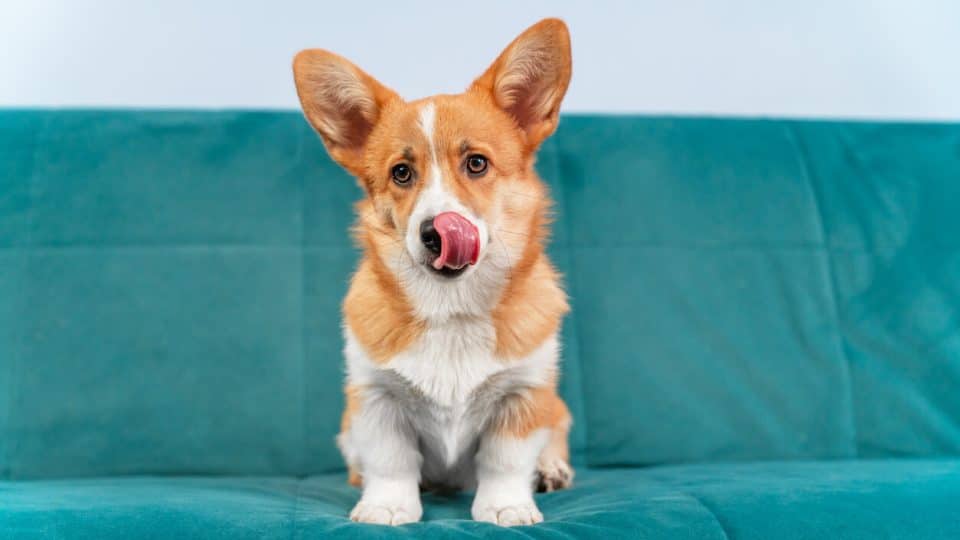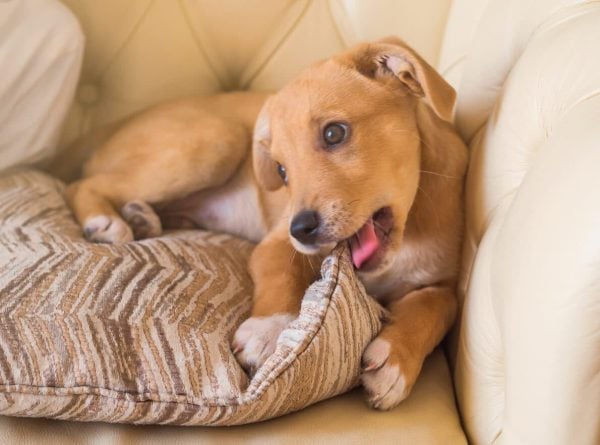- Not a substitute for professional veterinary help.
Does your dog lick the couch? You’re not alone! This behavior may seem a little unusual, but it’s not at all uncommon for dogs to lick couches and other things that aren’t food.
Dogs often lick couches, furniture, floors, and other household objects because these things have scents or textures dogs find interesting.
Your dog’s licking habit may be harmless, but it’s still a good idea to pay attention to this behavior. If your dog constantly licks your couch or other non-food items, they could have an underlying behavioral or medical issue that needs attention from your vet.
Read on to learn the most common reasons why dogs lick couches and how to get them to stop.
Reasons Dogs Lick Furniture, Carpets, and Other Non-Food Items
Dogs may lick non-food items, from couches to tables to your pants, for various reasons. The most common reasons include:
- Stress or anxiety: “Licking can be a self-soothing behavior, much like thumb-sucking in children,” says Dr. Jamie Richardson, head of veterinary medicine at Small Door Vet. “Dogs may lick beds, couches, or pillows to comfort themselves during times of stress or when left alone.”
- Boredom: Without enough mental stimulation or physical activity, dogs may resort to licking nearby objects like chairs or the coffee table to ease boredom and pass the time.
- Attention-seeking: If licking your couch gets a reaction from you, your dog might repeat the behavior to get your attention again.
- Scent marking: Dogs typically use urine and feces to mark their territory, but licking can also serve as a form of scent marking. If your dog tends to lick items you use often, like the couch, your pillow, or a favorite blanket, they may be trying to mix their scent with yours as a way to reinforce your bond.
- Grooming: Some dogs extend grooming behaviors to household items like throw blankets or rugs, especially if these items have a fur-like texture.
- Texture or taste: “Some dogs lick soft surfaces like blankets or carpets simply because they enjoy the residual texture or tastes, like food crumbs or skin oils,” Dr. Richardson says.
If your dog’s licking seems constant or compulsive, or they have any other unusual behaviors or symptoms, their licking may be due to an underlying medical or behavioral issue that requires professional support.
How To Get Your Dog To Stop Licking the Couch
If your dog licks your couch, chairs, or bedding, you don’t necessarily need to be alarmed—but you won’t want to ignore this behavior, either.
In many cases, you can reduce or stop the behavior through some simple changes at home. Finding the right solution can also help you narrow down the factors driving your dog’s licking.
Redirect your dog
When your dog starts licking something inappropriate, you can redirect them with a cue, like “Go to your bed,” or offer them a chew toy, lick mat, or puzzle toy, recommends Alexandra Bassett, owner, lead dog trainer, and behavior consultant at Dog Savvy.
By consistently redirecting and rewarding the alternative behavior, you’re helping your dog learn new, healthier habits that gradually replace misplaced licking, she says.
Tip: If your dog seems to enjoy the sensory texture of your couch, try offering a toy or lick mat made of a similar fabric.
Keep surfaces clean
Dogs generally find leftover grease, crumbs, and other food residues difficult to resist. You can get rid of these scents and traces by wiping down the surfaces your dog tends to lick with a pet-safe enzymatic cleaner, Bassett recommends.
If needed, you can follow up with a dog-safe deterrent spray, such as bitter apple. These sprays leave an unpleasant taste on the surface, which helps discourage your dog from going back to lick the same spot, she adds.
Tip: A couch cover can also protect your sofa from chronic licking and make it easier to clean.
Add more physical and mental enrichment
Boredom can lead dogs to seek out their own entertainment in less-than-ideal ways, like licking the couch.
“Providing puzzle toys, snuffle mats, or extra play sessions can redirect a dog’s focus and reduce boredom-driven licking,” Bassett says. “Enrichment meets a dog’s instinctual needs for foraging and problem-solving, making them less likely to develop compulsive habits like furniture licking.”
Address your dog’s underlying anxiety
If the licking happens during thunderstorms, when you leave your dog alone, or during other stressful events, anxiety could be the trigger.
Calming supplements, desensitization training, and a consistent routine can help. For moderate to severe anxiety, a vet may recommend medication or suggest working with a dog behaviorist.
Give your dog more undivided attention
Sometimes, dogs lick the couch as a way to get your attention, especially if they’ve learned it gets a reaction from you—whether that reaction is good or bad!
By spending more quality time with your dog during interactive play, walks, or cuddle sessions, you fulfill their social needs in more positive ways. This may reduce their urge to seek attention through licking.
Important: Dogs need at least one hour of your attention each day!
When Is Licking a Cause for Concern?
Licking itself is a natural behavior for dogs. It’s one of the ways they explore their world, soothe themselves, and interact with people or other animals. That said, there’s a difference between normal licking and licking behavior that may need attention.
Dr. Richardson explains that new or compulsive licking of household items can be a sign of:
- Pain
- Nausea
- Gastrointestinal discomfort
- Anxiety
- Cognitive dysfunction
- Neurological issues
Bassett adds that a condition known as pica can also lead dogs to lick or eat non-food items. A mineral deficiency may sometimes trigger pica. In other cases, this condition may develop due to obsessive-compulsive behavior rooted in boredom or a lack of mental stimulation.
Other signs that your dog’s licking may point to a more serious issue, like a medical or behavioral concern:
- Intervention doesn’t work: If redirection, training, or environmental changes don’t seem to have any effect, a professional can offer more support.
- It turns into excessive grooming: Dogs may shift from licking furniture to repeatedly licking themselves due to allergies, pain, or compulsive behavior.
- It’s paired with other symptoms. Licking paired with vomiting, appetite changes, drooling, or weight loss could suggest underlying medical issues, Dr. Richardson says.
- The behavior disrupts daily life: If licking interferes with sleep, play, eating, or relaxing, it’s time to consult a professional.
When in doubt, trust your gut. If your dog’s licking seems excessive, disruptive, or unmanageable, it’s always best to get more guidance from a vet or certified dog behaviorist.






